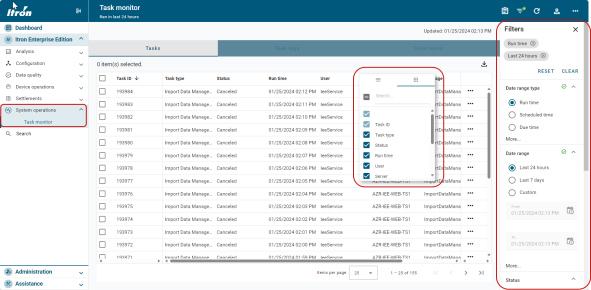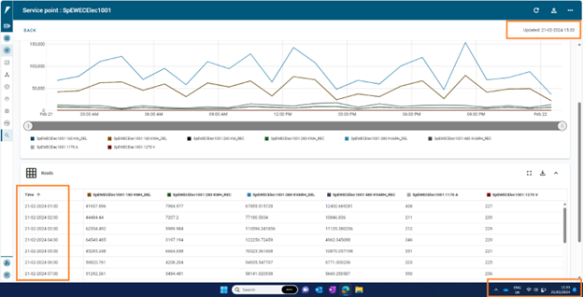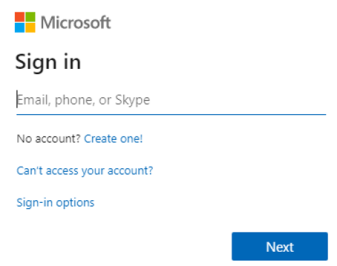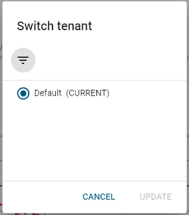Web UI new features and enhancements
This section lists new features that have been added in Web UI 3.0.
2588794: Entity search - Service point
Search is a new screen on the Web UI (available to users who have the View Customer Configuration permission). Accessible from the main menu, the Search interface allows users to specify one or more search criteria in the Query card, and then view the search results in the Results panel.
To search for service points, specify Service point as the Entity type. The Field values that can be specified in the search criteria are Account ID, Account number, Meter ID, Meter number, Meter program ID, Service point description, Service point program ID, and Version. By default, it will return currently active service points. If All is selected for Version, it will also return service points with effective dates in the past.

The search results are shown in a table, the columns include Service point ID, Service point description, Service point program ID, Start date, End date, Endpoint ID, External system, Meter ID, Meter number, Market type, Meter program ID, Recording device ID, Account ID, Account number, Customer ID, as well as a column for each User Defined Attribute (UDA), if any.
The Results table supports standard table functionality. The user can show and hide columns, change column orders, change column sorting, resize column widths, and more. Users can download the table contents to a file.
From the table, the user can launch the following actions:
-
Graph and analyze. Navigates the user to the Interactive graphing page.
-
View configuration. Navigates the user to the Configuration maintenance page.
-
View readings. Navigates the user to the Service point readings page.
2444616: Task monitor
Task monitor is a new screen on the Web UI (available to users who have the View Task Template permission). Accessible from the main menu under System operations, the Task monitor interface displays a table listing all tasks that meet the filter criteria.
The Task table supports standard table functionality. The user can show and hide columns, change column orders, change column sorting, resize column widths, and more. Users can download the table contents to a file.

To focus on monitoring the most important tasks, users can specify the filter criteria, such as date range, status, category, and so on. Just like on other screens, users can save it as a view. Users with different roles can monitor different tasks and import tasks that failed in the last 24 hours. If using ISAIM, users can create a view to show all SAP tasks in the last 7 days. Some table columns also allow filtering, such as Task ID (by entering an ID) and Message (by entering a keyword).
Users can drill down from a task to view the task logs or child tasks and perform actions on the individual task using the row level Actions menu, or on multiple tasks at once by selecting multiple items, and then use page level Actions menu. Actions include Cancel, Edit, Hold, Release, Move to history, and more. The actions that can be performed depend on the selected tasks and their status as well as the user’s permissions.
Users can refresh the screen manually or configure it to automatically refresh periodically. By default, the screen will not automatically refresh.

2706666: User preference settings
This release introduces new user preference settings that are observed by the Web UI, using a different approach from the rich client, which uses workgroup settings.
|
UI |
Observes |
Configured by |
Applicable to |
|---|---|---|---|
| Rich Client | Workgroup settings | Administrator | All users in the workgroup |
| Web UI | User preference settings | Each user | Each user |
This release supports two display settings. The UI for viewing and configuring these settings is not yet available. For now, they must be configured in the database using a script.
|
User preferences setting |
Description |
|---|---|
| Date/time format | All dates/times are displayed in the specified format |
| Time zone | All dates/times are displayed in the specified time zone |
The following example shows a user in the UK time zone (the local PC time: 21st Feb 2024 11:33), with the time zone setting configured to UTC+4 (the UI’s last updated time: 21st Feb 2024 15:33) and the date/time format setting configured to DD-MM-YYYY HH:mm (24-hour time format).

2893329: Hybrid architecture for IEE hosted customers
The following diagram shows a traditional architecture where all IEE components are a single tenant (database, services, APIs, and user interface) and are installed in the same environment: utility’s on-premises environment or Itron hosted environment.

IEE 10.4 and Web UI 3.0 now support deployment on a hybrid architecture for IEE hosted customers, as shown in the following diagram:

In a single tenant environment (left red box), if multiple utility customers are using the same database (for example, Oracle or SQL Server), the database schemas for each utility are separated, but they may sit on the same shared database server.
On the Itron multi-tenant platform (on Microsoft Azure), along with other Itron applications that are also multi-tenant (for example, IMS), there is a “tenant routing” mechanism, so that the multi-tenant application (middle gray box) can be routed to the correct single-tenant system (left red box).
Single sign-on with utility’s own Active Directory
Itron Identity uses Azure Active Directory (AAD) to federate a utility’s on-premises Active Directory. This way, users can have a single sign-on with the utility’s own Active Directory. The most common way of doing this is by using a Microsoft 365 subscription that comes with AAD.
Note: Applicable only to IEE Web UI (not the Rich client).

Access multiple Itron applications through one URL via internet
IEE applications can be accessed by going to the same Itron URL. The user will first need to be authenticated using their utility’s Active Directory. After the user has been authenticated, the applications they have licenses or permissions to access (for example, IEE, DI, OO) will display in the left navigation pane.

Manage multiple tenants through one UI
User permissions determine the tenants they can access. To select a different tenant, select the User icon (![]() ), and then select SWITCH TENANT.
), and then select SWITCH TENANT.

If a user has authorization to manage one tenant, they will only see one tenant.

If a user has authorization to manage multiple tenants, they can access each tenant, one tenant at a time in the same UI.

Data separation (multiple utilities or subsidiaries)
After the user selects a tenant, the “tenant routing” mechanism then routes the traffic from the multi-tenant platform to the correct single-tenant system. The data is separate for each utility. This approach ensures data separation. For example, for multiple utilities, or for when we have a parent utility company that has multiple subsidiaries underneath it, users from each subsidiary can only access their own tenant, and users from the parent company can access multiple tenants.
Continuous delivery (latest and greatest)
Applications on Itron multi-tenant platform adopt continuous delivery, getting the latest stable versions and bug fixes. IEE Web UI on the multi-tenant platform will have the latest and greatest content and will be version-aware with appropriate handling if the IEE backend (single-tenant) web services and database are on an older version.
2826042: Itron Common UI Portal Enhancements
A key component of the IEE Web UI is the Itron Platform, which includes both Itron Identity, to provide a centralized access control management, and Itron's common UI portal, to unify the user experience across all Web UI screens in IEE and other software products within Itron's portfolio. In this release, the Itron’s common UI portal has been enhanced to include a new, refreshed look and feel, modular architecture to support more rapid development of new screens, and performance improvements.
2668486: Identity Sync Service & Tenant management UI
This release supports deployment of a hybrid architecture for IEE hosted customers. See 2893329: Hybrid architecture for IEE hosted customers. When migrating from a traditional deployment to a hybrid architecture, the Identity Sync Service is used to synchronize the users, roles, and permissions from the existing IEE database to the Identity service in the cloud. For more information, refer to the Identity Sync Service User Guide.
After the synchronization is completed, the existing UI on IEE rich client for managing users, roles, and permissions will be disabled. From that point forward, the users, roles, and permissions must be managed through the Tenant Management UI. For more information, see Tenants.
Settlements
This section lists new Settlements features that have been added in Web UI 3.0.
2666190: Retail Settlement Configuration View and Edit
Retail Settlement configuration maintenance is a new screen on the Web UI. The Configuration maintenance page for Retail Settlement allows users to view and edit Retail Settlement entity configurations. For more information, see Configuration maintenance: Retail Settlement in the IEE MDM Help.
2666218: Enrollment Configuration View and Edit
Enrollment configuration maintenance is a new screen on the Web UI. The Configuration maintenance page for Enrollment allows users to view and edit Enrollment entity configurations. For more information, see Configuration maintenance: Enrollment in the IEE MDM Help.
2829904: Retailer Configuration View and Edit
Retailer configuration maintenance is a new screen on the Web UI. The Configuration maintenance page for Retailer allows users to view and edit Retailer entity configurations. For more information, see Configuration maintenance: Retailer in the IEE MDM Help.
2904373: Service Point Configuration View and Edit
Service point configuration maintenance is a new screen on the Web UI. The Configuration maintenance page for Service point allows users to view and edit service point entity configurations. For more information, see Configuration maintenance: Service point in the IEE MDM Help.
2904476: Meter Configuration View and Edit
Meter configuration maintenance is a new screen on the Web UI. The Configuration maintenance page for Meter allows users to view and edit Meter entity configurations. For more information, see Configuration maintenance: Meter in the IEE MDM Help.